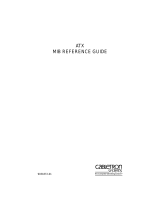
U
SING
THIS
G
UIDE
This guide provides an overview as well as instructions for installing and configuring the SFVRA
Configuration Manager (also referred to as SFVRA-CFG). This guide has been written for the
network administrator responsible for setting-up, configuring, and maintaining networks
configured using SFVRA-CFG.
ABOUT THIS GUIDE
The User’s Guide is divided into the following chapters:
System Overview provides a basic description of the SFVRA-CFG network, an interoperability
overview, a brief description of system components, and a list of system requirements.
System Installation provides a step-by-step description of installing your SFVRA-CFG.
Using the SFVRA-CFG Application provides instructions for starting up the SFVRA-CFG
application, and also instructions for using the menu option and tool bars for configuration. A
discussion of SFVRA-CFG system messages is also included.
Configuring Tables provides instructions for configuring a product code table and an SFVRA table.
Information configured in these tables is incorporated later when entering other configuration
information.
Configuring Site Templates provides instructions for defining SFVRA-CFG site templates. A site
template is a time-saving tool, allowing you to configure a template of basic site information that
can be used over and over when configuring similar sites.
Configuring Sites provides instructions for defining individual sites. For each site you will enter
various site properties (including the site template you wish to use for this site), optional contact
information, and the systems associated with this site.
Configuring Circuits provides instructions for defining the site’s circuit information. Circuits are the
physical WAN connections to each system. Circuit information includes line properties, and where
applicable, data link and access information.
Configuring Connection Groups provides instructions for establishing connection groups among the
configured sites. Connection groups allow you to divide a network into groups of sites that need
to intercommunicate. Within each group, you can select a central site for the group, creating a star
configuration.
Configuring IP Network Information provides instructions for defining IP subnets, then entering IP
information for that subnet. This chapter also provides instructions for entering IP information for
individual systems. IP network information defines how an IP network will interconnect.
Configuring IPX Network Information provides instructions for defining IPX segments, then entering
IPX information for that segment. This chapter also provides instructions for entering IPX
information for individual systems. IPX network information defines how an IPX network will
interconnect.





























